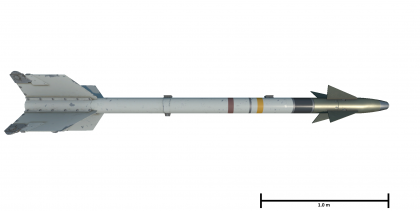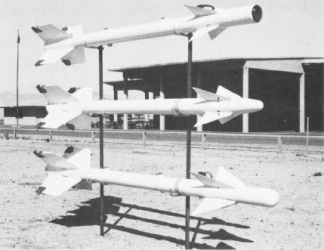Difference between revisions of "AIM-9C Sidewinder"
Inceptor57 (talk | contribs) (→External links: Added archive info) |
Inceptor57 (talk | contribs) m (→Usage) |
||
| Line 51: | Line 51: | ||
Though the AIM-9C was received by the US Navy, its more complicated seeker compared to the infrared seeker variant introduced technical issues. China Lake's development team, including Amlie himself, arrived at the ''Essex''-class carriers to provide orientation and support for the missiles. The biggest issue aside from the missile was the Crusader's radar, which can fail and was difficult to repair. Pilot confidence in the missile was also poor, both in regards to the Crusader's radar reliability and the AIM-9C's ability for an all-aspect attack with the radar.<ref name="Westrum_ChinaLakeAIM9_Usage">Westrum 2013, p.184-186</ref> | Though the AIM-9C was received by the US Navy, its more complicated seeker compared to the infrared seeker variant introduced technical issues. China Lake's development team, including Amlie himself, arrived at the ''Essex''-class carriers to provide orientation and support for the missiles. The biggest issue aside from the missile was the Crusader's radar, which can fail and was difficult to repair. Pilot confidence in the missile was also poor, both in regards to the Crusader's radar reliability and the AIM-9C's ability for an all-aspect attack with the radar.<ref name="Westrum_ChinaLakeAIM9_Usage">Westrum 2013, p.184-186</ref> | ||
| − | However the ultimate failing of the AIM-9C's is its purpose filling a niche role on an aircraft with a specific radar requirement, being meant for the Crusader because the aircraft could not carry the AIM-7 Sparrows. Once the Crusaders began being phased out in the mid-1960s, the AIM-9C was phased out alongside the Crusaders as newer aircraft like the [[F-4C|F-4C Phantom II]] that can use Sparrows were put into use. With the AIM-9C only seeing brief service before its retirement with the Crusaders, only 1,000 AIM-9Cs were produced by Motorola between 1965 to 1967.<ref name="Designation_Sidewinder"/> There were no kill claims during the Vietnam War credited to the AIM-9C.<ref name="MiGKillers">McCarthy 2009</ref> | + | However the ultimate failing of the AIM-9C's is its purpose filling a niche role on an aircraft with a specific radar requirement, being meant for the Crusader because the aircraft could not carry the AIM-7 Sparrows. Once the Crusaders began being phased out in the mid-1960s, the AIM-9C was phased out alongside the Crusaders as newer aircraft like the [[F-4C|F-4C Phantom II]] that can use Sparrows were put into use. With the AIM-9C only seeing brief service before its retirement with the Crusaders, only 1,000 AIM-9Cs were produced by Motorola between 1965 to 1967.<ref name="Designation_Sidewinder"/> There were no kill claims during the Vietnam War credited to the AIM-9C.<ref name="MiGKillers">McCarthy 2009, p.148-157</ref> |
The AIM-9C would have another chance in the 1980s. Making use of the inventory of AIM-9Cs that have been phased out of use, the US Navy converted the AIM-9Cs into the AGM-122A ''SideARM'' ("Sidewinder Anti-Radiation Missile") for use against radar installations. In 1984, Motorola was contracted to perform the conversions, which utilized a broader-band seeker and a new proximity fuse used on the more modern Sidewinder anti-air missiles. While not as useful as a dedicated anti-radiation missile, the AGM-122A provided a cost-effective solution against smaller radar threats. The primary users of the AGM-122A was the United States Marine Corps, who received 700 units between 1986 to 1990 and equipped on helicopters or fixed-wing jets.<ref name="Designation_Sidearm">Parsch 2002</ref><ref name="Westrum_ChinaLakeAIM9_AGM122">Westrum 2013, p.186</ref> Once the AIM-9C inventory ran out, there were considerations to restart production for new missiles as the AGM-122B with new guidance system and a reprogrammable memory board, but this was cancelled.<ref name="Designation_Sidearm">Parsch 2002</ref> | The AIM-9C would have another chance in the 1980s. Making use of the inventory of AIM-9Cs that have been phased out of use, the US Navy converted the AIM-9Cs into the AGM-122A ''SideARM'' ("Sidewinder Anti-Radiation Missile") for use against radar installations. In 1984, Motorola was contracted to perform the conversions, which utilized a broader-band seeker and a new proximity fuse used on the more modern Sidewinder anti-air missiles. While not as useful as a dedicated anti-radiation missile, the AGM-122A provided a cost-effective solution against smaller radar threats. The primary users of the AGM-122A was the United States Marine Corps, who received 700 units between 1986 to 1990 and equipped on helicopters or fixed-wing jets.<ref name="Designation_Sidearm">Parsch 2002</ref><ref name="Westrum_ChinaLakeAIM9_AGM122">Westrum 2013, p.186</ref> Once the AIM-9C inventory ran out, there were considerations to restart production for new missiles as the AGM-122B with new guidance system and a reprogrammable memory board, but this was cancelled.<ref name="Designation_Sidearm">Parsch 2002</ref> | ||
Revision as of 15:26, 18 November 2021
Contents
Description

Write an introduction to the article in 2-3 small paragraphs. Briefly tell us about the history of the development and combat using the weaponry and also about its features. Compile a list of air, ground, or naval vehicles that feature this weapon system in the game.
Vehicles equipped with this weapon
General info
Tell us about the tactical and technical characteristics of the missile.
Effective damage
Describe the type of damage produced by this type of missile (high explosive, splash damage, etc)
Comparison with analogues
Give a comparative description of missiles that have firepower equal to this weapon.
Usage in battles
Describe situations when you would utilise this missile in-game (vehicle, pillbox, base, etc)
Pros and cons
Pros:
- Being a semi-active radar homing (SARH) missile, it has all-aspect ability and is immune to flares
- Begins turning almost immediately after launch, compared to AIM-7 sparrows and its variants which travel in a straight line for a short amount of time before tracking
- Has the good range of the AIM-9D (3 km range from rear aspect)
Cons:
- Being a SARH missile, its usefulness is limited on low-altitude targets due to ground clutter
- Requires constant radar lock
- Unreliable outcome: sometimes it pulls hard and hits manoeuvring targets, sometimes it misses a target flying in a straight line
- Tends to lose lock when the target turns in a direction, then quickly turns the opposite way
History
Development
Limitations in the initial Sidewinder model, the AAM-N-7 Sidewinder IA (later designated in 1963 the AIM-9B), caused the United States Navy to begin developing the next generation of Sidewinders at China Lake. The goal was to improve the missile's envelope, as the Sidewinder's restricted turning ability meant that aware pilots can easily turn and evade the incoming missile. Development on this new Sidewinder missile soon split into two separate project for different seeker heads, one with an infrared alternative head (IRAH) as the Sidewinder 1C Mod 29, which would become the AIM-9D, and the other with a semi-active radar alternative head (SARAH) as the Sidewinder 1C Mod 30, which would become the AIM-9C.[1] A SARAH guidance system was useful in that it would allow a Sidewinder that did not require a tail attack to effectively use, allowing head-on strikes, and was all-weather, not interfered by the environmental factors like a IR seeker was.[2]
The AIM-9C shared the same missile improvements as the AIM-9D, namely a Hercules MK 36 solid-fuel rocket motor that allowed the missile to go faster and as far as 18 km, large fins for control, and a MK 48 continuous-rod warhead for increased lethality.[3]
Starting development in 1957 under Thomas S. Amlie, the AIM-9C's intent was to provide a fleet-defense weapon for aircraft on the World War II-era Essex-class carriers, which carried the F-8 Crusader aircraft that could not carry the larger AIM-7 Sparrow SARAH missiles. Developing a working radar seeker was difficult, with the development team reviewing the technical reports of the AIM-4A Falcon to fix some issues. However, another issue with the AIM-9C's development is finding a suitable radar that could use it, as the AIM-9C called for the use of a 24-inch diameter radar while the Crusader used a 13-inch diameter radar. This would eventually be resolved with the Crusaders integrating a AN/APQ-83 radar. The AIM-9C went through operational evaluation with the US Navy in 1964, alongside the AIM-9D, and the AIM-9C demonstrated a 77% single-shot kill probability. Two F-8 squadron based in NAS Miramar were equipped with AIM-9C by the fall of 1964.[2] Production of the missiles were carried out by Motorola.[3]
Usage
Though the AIM-9C was received by the US Navy, its more complicated seeker compared to the infrared seeker variant introduced technical issues. China Lake's development team, including Amlie himself, arrived at the Essex-class carriers to provide orientation and support for the missiles. The biggest issue aside from the missile was the Crusader's radar, which can fail and was difficult to repair. Pilot confidence in the missile was also poor, both in regards to the Crusader's radar reliability and the AIM-9C's ability for an all-aspect attack with the radar.[4]
However the ultimate failing of the AIM-9C's is its purpose filling a niche role on an aircraft with a specific radar requirement, being meant for the Crusader because the aircraft could not carry the AIM-7 Sparrows. Once the Crusaders began being phased out in the mid-1960s, the AIM-9C was phased out alongside the Crusaders as newer aircraft like the F-4C Phantom II that can use Sparrows were put into use. With the AIM-9C only seeing brief service before its retirement with the Crusaders, only 1,000 AIM-9Cs were produced by Motorola between 1965 to 1967.[3] There were no kill claims during the Vietnam War credited to the AIM-9C.[5]
The AIM-9C would have another chance in the 1980s. Making use of the inventory of AIM-9Cs that have been phased out of use, the US Navy converted the AIM-9Cs into the AGM-122A SideARM ("Sidewinder Anti-Radiation Missile") for use against radar installations. In 1984, Motorola was contracted to perform the conversions, which utilized a broader-band seeker and a new proximity fuse used on the more modern Sidewinder anti-air missiles. While not as useful as a dedicated anti-radiation missile, the AGM-122A provided a cost-effective solution against smaller radar threats. The primary users of the AGM-122A was the United States Marine Corps, who received 700 units between 1986 to 1990 and equipped on helicopters or fixed-wing jets.[6][7] Once the AIM-9C inventory ran out, there were considerations to restart production for new missiles as the AGM-122B with new guidance system and a reprogrammable memory board, but this was cancelled.[6]
Media
Excellent additions to the article would be video guides, screenshots from the game, and photos.
See also
Links to the articles on the War Thunder Wiki that you think will be useful for the reader, for example:
- reference to the article about the variant of the weapon;
- references to approximate analogues by other nations and research trees.
External links
- References
- Bibliography
- McCarthy, Donald J. Jr. MiG Killers, A Chronology of U.S. Air Victories in Vietnam 1965–1973. Specialty Press, 2009.
- Parsch, Andreas. "AGM-122." Directory of U.S. Military Rockets and Missiles, Designation-Systems.Net, 08 November 2002, Website. Accessed on 18 Nov. 2021 (Archive).
- Parsch, Andreas. "AIM-9." Directory of U.S. Military Rockets and Missiles, Designation-Systems.Net, 09 July 2008, Website. Accessed on 18 Nov. 2021 (Archive).
- Westrum, Ron. Sidewinder; Creative Missile Development at China Lake. Naval Institute Press, 30 Sep. 2013.





